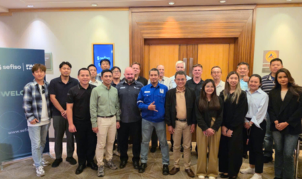Types of Obstruction Lights
Obstruction Lights are broadly divided into three following parts–
- Low Intensity Obstruction Lights : These lights should be used where the object is a less extensive one and its height above the surrounding ground is less than 45 m.
- Medium Intensity Obstruction Lights : Medium Intensity obstacle lights should be used where the object is an extensive one or its height above the level of the surrounding ground is greater than 45m.
- High Intensity Obstruction Lights : These lights should be used to indicate the presence of an object if its height above the level of the surrounding ground exceeds 150m.
According to ICAO regulations Obstruction lights are divided in following types –
- Low Intensity – Type A : Red color steady lights are used for fixed obstacles. Their minimum intensity should be 10 candelas.
- Low Intensity – Type B : Red color steady lights are used for fixed obstacles. Their minimum intensity should be 32 candelas.
- Low Intensity – Type C : These Yellow/Blue color flashing lights are used for mobile obstacles. Their minimum intensity should be 40 candelas.
- Low Intensity – Type D : These Yellow color flashing lights are used for “Follow me” Vehicles. Their minimum intensity should be 200 candelas.
- Medium Intensity – Type A : White color flashing lights are used for obstacles having height more than 45 meters. Their minimum intensity should be 2000 candelas.
- Medium Intensity – Type B : Red color flashing lights are used for obstacles having height more than 45 meters. Their minimum intensity should be 2000 candelas.
- Medium Intensity – Type C : Red color fixed lights are used for obstacles having height more than 45 meters. Their minimum intensity should be 2000 candelas.
- High Intensity – Type A : White color flashing lights are used for obstacles having height more than 150 meters. Their minimum intensity should be 2000 candelas.
- High Intensity – Type B : White color flashing lights are used for obstacles having height more than 150 meters. Their minimum intensity should be 2000 candelas.
Types of Obstacle Markers
Obstructions in the airway path are generally marked with three types of Markers –
- Flags : Flags used to mark objects shall be displayed around, on top of, or around the highest edge of, the object.
- Colored Patterns : Colored patterns used to mark objects should consist of rectangles of not less than 1.5 m and not more than 3 m on a side, the corners being of the darker color.
- Obstruction Lights : The presence of objects which must be lighted shall be indicated by low, medium or high intensity obstacle lights, or a combination of such lights.
Obstruction Light Selection for Vertical Structures
|
ELEVATION |
MARKED |
Low Intensity Obstruction Light Type - A/B |
Medium Intensity Obstruction Light Type - A |
Medium Intensity Obstruction Light Type - B/C |
High Intensity Obstruction Light Type - A |
| <45m | YES | only night | |||
| <45m | NO | only night | |||
| >45m <105m | YES | only night 1 |
|
only night 2 | |
| >45m <105m | YES | only night | |||
| >45m <105m | NO | day night | |||
| >105m <150m | YES | only night 1 | only night 2 | ||
| >105m <150m | YES | only night | |||
| >105m <150m | NO | day night | |||
| >150m | YES | only night 1, 3 | only night 2 | ||
| >150m | YES | only night 3 | |||
| >150m | YES | day night 4 | |||
| >150m | NO | day night 3 | |||
| >150m | NO | day night 4 |
- Lower Level
- Upper Level
- More Than one level (Distance between levels 52m maximum)
- More Than one level (Distance between levels 75m maximum)



